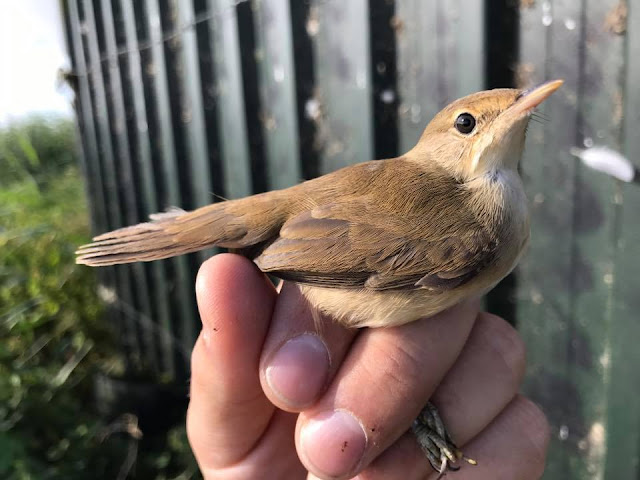Since the last update we have been ticking along with the various projects and had particular success with the Sand Martin ringing at Grangemore. As mentioned in the previous post the Irish Open Golf Tournament was being held at our main ringing site so we had to steer clear for a few weeks as they turned it into a mini city and hosted over 92,000 people.
Two weekends ago we did visit 2 to Grangemore in perfect conditions and caught another 145 new
Sand Martins, retrapping 19 from visit 1 and the previous year. The productivity of the colony looks to be fantastic this year and we ringed 91 juveniles amongst the catch.
The following evening I did a quick visit to Macfin for the first time this year. My main interest here was to catch a number of retrap Sand Martins from previous years, so I was pleased to get 12 out of a catch of 33 birds. Two of these were adults from 2014, one of which was recovered in Anglesey, Wales in the autumn of 2014 and now has been retrapped by us again in 2016 and 2017.
Elsewhere around the estuary in the past week I did net restricted visits at Portstewart Strand and Grangemore. The PSS catch was very disappointing and no warblers were caught when two days previous there had been Willow Warblers everywhere. I heard only two through the morning so perhaps the first wave have moved south - I know the first trickle have started to pass through the coastal bird observatories of the UK.
Juvenile Lesser Redpoll
The Grangemore visit was targeting
Sedge Warblers so I had placed 3 nets across the main ditch that splits the marsh. The catch of 13 Sedge Warblers were very good considering the minimal amount of habitat covered and it was good to see lots of fresh juveniles (adult pictured below). That takes us to 20 for the year at the site so far with probably more to come over the next six weeks.
Sedge Warbler
Portstewart Strand/Grangemore New Retrap Blackbird 1
Dunnock 1 1
Great Tit 1
Lesser Redpoll 2
Linnet 2 Meadow Pipit 2
Reed Bunting 1
Robin
Sedge Warbler 16
Totals 26 1
Back on the 5th we had out first attempt at
Storm Petrel ringing for the year. The conditions weren't quite what we has expected and we got rained off after an hour but we did catch the first Stormie of the year plus a BTO control.
Storm Petrel
The control ring sequence looked familiar to birds we have trapped before so a quick message to the Calf of Man Bird Observatory confirmed that it was one of their birds ringed on the 13th of August last year. This is the seventh bird we have traded with the CoM, four of theirs to us and three back the other way.
The forecast looks decent for early next week so we hope to get back out and catch a few more.
We have had two short spells back out on the rivers with a couple of C permit holders who were seeking to get some experience ringing over rivers and to handle some new species. We had a decent total catch of 3
Kingfishers, 2
Dippers (1 a retrap) and a
Grey Wagtail.

Kingfisher
John and Ken did a bit of ringing around the university last week with a catch of around 30 birds. The catch was made up mostly of tits but did include some quality with
Blackcap,
Willow Warbler and a retrap Sedge Warbler from last year.
We would also like to take the opportunity to thank the
National Museums Northern Ireland (NMNI) and specifically the
Centre for Environmental Data and Recording (CEDaR) who have kindly given us funding of
£756 from the Environmental Recorders Group Fund. With this money we have been able to purchase some new nets, poles and rings which will greatly help with our various projects!
NMNI Website -
https://nmni.com/home.aspx
CEDaR -
https://nmni.com/cedar
We are heading down to the west shore of Lough Neagh tomorrow morning to do a bit of reedbed ringing in the hopes of catching a few Acro warblers. We are probably some 30 miles north of the northern range of breeding Reed Warblers in Ireland so they are a species we never catch but should be on the cards tomorrow. I'll possibly update on that soon but no doubt it will take me a few weeks to a month on current form!
Dark-green Fritillary - nice feature of our Bann Estuary ringing sites in July






